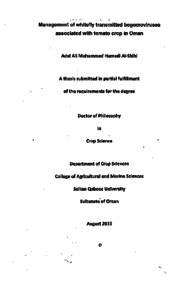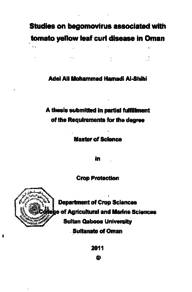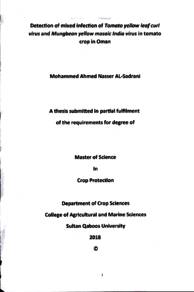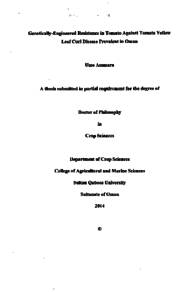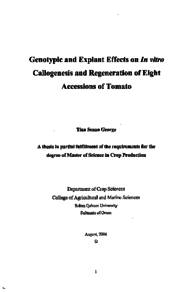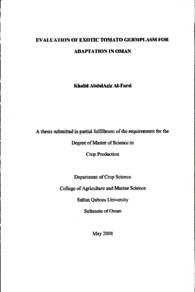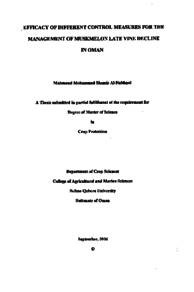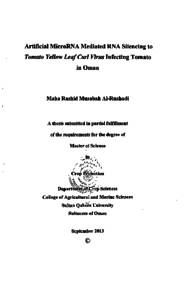وثيقة
Management of whitefly transmitted begomoviruses associated with tomato crop in Oman
الناشر
Sultan Qaboos University
ميلادي
2015
اللغة
الأنجليزية
الملخص الإنجليزي
Tomato yellow leaf curl (TYLC) is a complex of begomovirus species which are transmitted exclusively by whitefly (Bemisia tabaci). Typical symptoms of this disease yellowing, upward leaf curling and severe stunting of the whole plant. A survey was conducted for collecting whiteflies from 2-3 farms per Wilayat from different crops. Total nucleic acid isolated from single whitefly was used as template to amplify a fragment of 220 bp from the B biotype and 400 bp for the Q biotype of the mtCOI gene of whitefly using the primers Bem23F/Bem23R. All the samples showed fragment of 200 bp indicating the presence of B biotype. Six primer pairs were used RbF/RbR (900bp), 92F/HbR (700bp), Ars23S-1/Ars23R-2 (580bp), Wol16SF/Wol16SR (650bp), CFBF/CFBR (500bp) and U23F/23SIGR (600bp) to determine the the secondary symbionts associated with whitefly Bemisia tabaci. Only a fragment of 710 bp was amplified in all the screened samples indicating the presence of Hamiltonella species. Agryl cover was used in field experiments in two successive years to evaluate the optimum period for covering the tomato plants against whitefly transmitted begomoviruses. The covering period of 6-7 weeks proved to be the best for getting the highest yield (3kg/plant) with less TYLCV infection. Tomato crops showing begomovirus-like symptoms were collected from three commercial farms at Barka, cloned and sequenced. The results showed the presence of a new begomovirus species which was named Tomato leaf curl Barka virus (TOLCBrV). Fourteen tomato inbred lines carrying Ty begomovirus resistant genes have brought from the Agricultural Vegetable Research and Development Center (AVRDC) and screened against begomoviruses under field conditions in two successive years and also under controlled conditions. Twelve out of fourteen tomato inbred lines showed high resistance against different begomoviruses under field conditions 3 months post transplanting. Six begomovirus species were cloned from different tomato inbred lines Tomato yellow leaf curl virus (TYLCV), Chilli leaf curl virus (ChLCV), Tomato leaf curl Al Batinah virus (TOLCABV), Tomato leaf curl Oman virus (TOLCOMV), Tomato leaf curl Barka virus (ToLCBrV) and Cotton leaf curl Gezira virus (CLCuGeV). An agroinfectious clone of TYLCV was constructed and used to inoculate 14 tomato inbred-lines to see their susceptibility toward TYLCV under controlled conditions. Twelve inbredlines were found resistant against TYLCV. The tomato inbred lines with Ty genes did not develop disease symptoms up to 85 days post inoculation (DPI). Three techniques were used to detect the virus in the plants: southern hybridization, polymerase chain reaction (PCR) and real time PCR (qPCR) at the periods 5, 35 and 85 (DPI). The virus was detected clearly at 5 (DPI) by all techniques, at 35 (DPI) by PCR and qPCR and at 85 (DPI) by qPCR which indicate largely to the restriction of the virus to the inoculated leaf. However, susceptible line 3022E and GS 12 develop severe symptoms yellowing and curling and virus titer was increased from one period to next in comparison to resistant lines where the virus titer decreased from one period to next. These tomato lines are promising and can be used under Oman conditions and offer alternative option to the local susceptible varieties that have been used in Oman, leading to savings in money, time and labor.
المجموعة
URL المصدر
الملخص العربي
يعتبر فيروس تجعد واصفرار أوراق الطماطم من المسببات المرضية الرئيسية على محصول الطماطم في السلطنة.
هذا الفيروس ينتمي إلى الجنس البيجوموفيروس من عائلة الجيمينيفيروس والذي ينتقل عن طريق الذبابة البيضاء Bemisia tabaci. هذا الفيروس له دور رئيسي في التسبب في خسائر اقتصادية كبيرة المحصول الطماطم في جميع أنحاء العالم و في عمان ايضا وقد لوحظت بعض الأعراض لهذا المرض والمتمثلة في اصفرار وتجعد أوراق الطماطم, نقص في مساحة الأوراق والتقزم الشديد للنبات بشكل كامل إذا حدثت الإصابة في مراحل النمو المبكرة للنبات. تم استخلاص الحمض النووي للذبابة البيضاء واستخدامه كقالب لتضخيم القطعة التعريفية لمعرفة النوع باستخدام تفاعل السلسلة المتبلورة لمعرفة نوع الفصيل الموجود بالاضافة لنوع البكتيريا المصاحبة لكل نوع من الذبابة البيضاء. وقد استخدمت البادئة Bem23F/ Bem23R المعرفة النوع بالاضافة الى البوادي التالية- RbF / RbR ( 900bp ) , 92F / FbR ( 700bp ) , Ars23S (500bp), CFBF/CFBR (650bp), (580bp) Wol16SF/Wol16SR1/Ars23R-2(U23F / 23SIGR ( 600bp لمعرفة نوع البكتيريا المصاحبة للفصيل.
اسفرت النتائج عن تضخيم القطعة بحجم 220 bp والتي تدل على وجود النوع ب وتضخيم القطعة بحجم bp710 والتي تدل على وجود البكتيريا هاميلتونيلا الصاحبة للنوع ب وذلك في كل العينات التي تم فحصها. وفي تجربة أخرى تم استخدم غطاء الإجريل في الحقل على فترات مختلفة لتغطية نبات الطماطم وذلك لتحديد أي الفترات الأكثر ملائمة التغطية نبات الطماطم ضد الذبابة البيضاء وقد أظهرت النتائج أن تغطية المحصول لفترة تتراوح مابين سته الى سبعة أسابيع بالاجريل كانت أفضل فترة للحصول على أفضل انتاج بالإضافة للحماية الجيدة ضد هذا الفيروس. تم جمع وتحليل بعض العينات من اوراق الطماطم التي تظهر عليها اعراض الإصابة الفيروسية لهذا المرض من ثلاث مزارع للطماطم الكائنة في ولاية بركاء حيث أظهرت النتائج عن وجود صنف جديد للبيجوموفيروس وقد اطلق عليه فيروس تجعد اوراق الطماطم بركاء مع وجود بعض الفيروسات الأخرى التي قد سجلت مسبقا في السلطنة. في دراسة اخرى تم احضار اربعة عشر صنف من أصناف الطماطم التي تحتوي على جينات طبيعية مقاومة ضد البيجوموفيروس من مركز التنمية والتطوير الزراعي في تيوان لتجربتها وزراعتها في السلطنة واختبار مدى مقاومتها لهدا النوع من الفيروسات. وقد اظهرت النتائج التي أجريت في الحقل المدة موسمين متتاليين عن مقاومة اثني عشر صنف من أصناف الطماطم لهذا الفيروس على الرغم من وجود حوالي ستة أصناف من البيجوموفيرس والتي تم عزلها من مختلف اصناف الطماطم. نفس النتائج تم الحصول عليها عندما تم نقل العدوى اصطناعيا لأصناف الطماطم الأربعة عشر عن طريق استخدام الجين المسبب للعدوى من فيروس البيجوموفيروس في البيت المحمي تحت ظروف درجة حرارة ورطوبة معينة. ايضا أظهرت التحاليل المختبرية والتي تمت عن طريق استخدام ثلاث تقنيات وهي تفاعل السلسلة المتبلورة وتفاعل السلسة المتبلورة الكمي والتهجين الكمي عن اعاقة الحركة الفيروس وقلة كميته من الورقة السفلية التي تم نقل العدوى الفيروسية لها الى الاجزاء العلوية من النبات بالعكس من الأصناف الحساسة والتي تبين من خلالها عن زيادة في كمية الفيروس والمتمثل بالحمض النوي من فترة الى اخرى. استخدام اصناف مقاومة للبيجوموفيروسات سيكون له اثر ايجابي في تقليل الخسائر التي تنتج من الإصابة بهذا النوع من الفيروسات والتي بدورها تؤدي لحفظ المال والوقت والجهد.
هذا الفيروس ينتمي إلى الجنس البيجوموفيروس من عائلة الجيمينيفيروس والذي ينتقل عن طريق الذبابة البيضاء Bemisia tabaci. هذا الفيروس له دور رئيسي في التسبب في خسائر اقتصادية كبيرة المحصول الطماطم في جميع أنحاء العالم و في عمان ايضا وقد لوحظت بعض الأعراض لهذا المرض والمتمثلة في اصفرار وتجعد أوراق الطماطم, نقص في مساحة الأوراق والتقزم الشديد للنبات بشكل كامل إذا حدثت الإصابة في مراحل النمو المبكرة للنبات. تم استخلاص الحمض النووي للذبابة البيضاء واستخدامه كقالب لتضخيم القطعة التعريفية لمعرفة النوع باستخدام تفاعل السلسلة المتبلورة لمعرفة نوع الفصيل الموجود بالاضافة لنوع البكتيريا المصاحبة لكل نوع من الذبابة البيضاء. وقد استخدمت البادئة Bem23F/ Bem23R المعرفة النوع بالاضافة الى البوادي التالية- RbF / RbR ( 900bp ) , 92F / FbR ( 700bp ) , Ars23S (500bp), CFBF/CFBR (650bp), (580bp) Wol16SF/Wol16SR1/Ars23R-2(U23F / 23SIGR ( 600bp لمعرفة نوع البكتيريا المصاحبة للفصيل.
اسفرت النتائج عن تضخيم القطعة بحجم 220 bp والتي تدل على وجود النوع ب وتضخيم القطعة بحجم bp710 والتي تدل على وجود البكتيريا هاميلتونيلا الصاحبة للنوع ب وذلك في كل العينات التي تم فحصها. وفي تجربة أخرى تم استخدم غطاء الإجريل في الحقل على فترات مختلفة لتغطية نبات الطماطم وذلك لتحديد أي الفترات الأكثر ملائمة التغطية نبات الطماطم ضد الذبابة البيضاء وقد أظهرت النتائج أن تغطية المحصول لفترة تتراوح مابين سته الى سبعة أسابيع بالاجريل كانت أفضل فترة للحصول على أفضل انتاج بالإضافة للحماية الجيدة ضد هذا الفيروس. تم جمع وتحليل بعض العينات من اوراق الطماطم التي تظهر عليها اعراض الإصابة الفيروسية لهذا المرض من ثلاث مزارع للطماطم الكائنة في ولاية بركاء حيث أظهرت النتائج عن وجود صنف جديد للبيجوموفيروس وقد اطلق عليه فيروس تجعد اوراق الطماطم بركاء مع وجود بعض الفيروسات الأخرى التي قد سجلت مسبقا في السلطنة. في دراسة اخرى تم احضار اربعة عشر صنف من أصناف الطماطم التي تحتوي على جينات طبيعية مقاومة ضد البيجوموفيروس من مركز التنمية والتطوير الزراعي في تيوان لتجربتها وزراعتها في السلطنة واختبار مدى مقاومتها لهدا النوع من الفيروسات. وقد اظهرت النتائج التي أجريت في الحقل المدة موسمين متتاليين عن مقاومة اثني عشر صنف من أصناف الطماطم لهذا الفيروس على الرغم من وجود حوالي ستة أصناف من البيجوموفيرس والتي تم عزلها من مختلف اصناف الطماطم. نفس النتائج تم الحصول عليها عندما تم نقل العدوى اصطناعيا لأصناف الطماطم الأربعة عشر عن طريق استخدام الجين المسبب للعدوى من فيروس البيجوموفيروس في البيت المحمي تحت ظروف درجة حرارة ورطوبة معينة. ايضا أظهرت التحاليل المختبرية والتي تمت عن طريق استخدام ثلاث تقنيات وهي تفاعل السلسلة المتبلورة وتفاعل السلسة المتبلورة الكمي والتهجين الكمي عن اعاقة الحركة الفيروس وقلة كميته من الورقة السفلية التي تم نقل العدوى الفيروسية لها الى الاجزاء العلوية من النبات بالعكس من الأصناف الحساسة والتي تبين من خلالها عن زيادة في كمية الفيروس والمتمثل بالحمض النوي من فترة الى اخرى. استخدام اصناف مقاومة للبيجوموفيروسات سيكون له اثر ايجابي في تقليل الخسائر التي تنتج من الإصابة بهذا النوع من الفيروسات والتي بدورها تؤدي لحفظ المال والوقت والجهد.
قالب العنصر
الرسائل والأطروحات الجامعية

